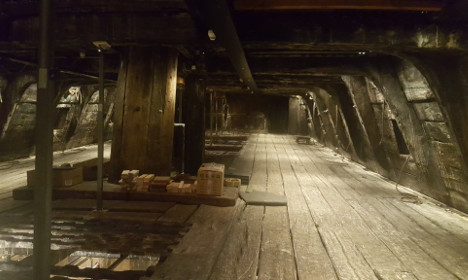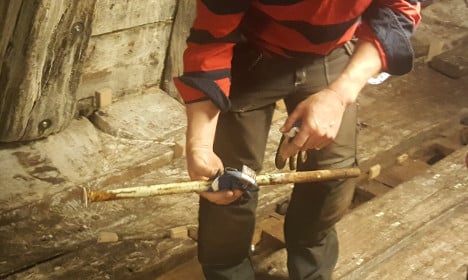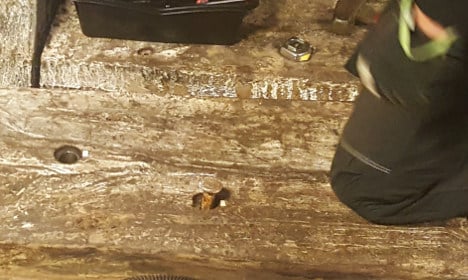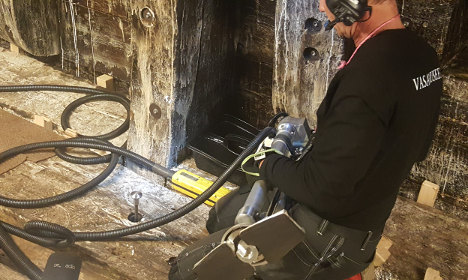Why the Vasa is getting a makeover... and losing weight

Why is Scandinavia's most visited museum losing weight? The Local takes a once in a lifetime chance to step on board the Vasa and find out.
Visited by more than 1.3 million people last year, Stockholm’s Vasa Museum is a Swedish national treasure, and one that was voted the ninth best museum in the world by Trip Advisor users in 2015.
But the country's most popular tourist attraction now requires urgent work to make sure it survives for future generations. Over 5000 rusty old bolts are in danger of damaging the iconic craft, and in order to prevent that from happening, the museum has been forced to take the risk of removing and replacing the pins, one by one.

There are already lengthy queues when The Local arrives at the Vasa Museum at 8.30am. Photo: The Local
It was with more than a touch of hesitation then that The Local prepared to step on board the 17th-century war ship on Wednesday to witness the delicate process of preserving it for hundreds of years to come.
That sensation was only heightened when one of the individuals in charge of the project revealed just how rare it is for anyone to set foot on the doomed royal battle ship.
“We normally reserve this for Nobel Prize winners, but today is a special day,” Swedish National Maritime Museum director Leif Grundberg noted, as stomachs collectively lurched.
Quite a strange sensation to stand on something that sat on the seabed for hundreds of years. pic.twitter.com/GoPG1MvsHg
— Lee Roden (@LeeRoden89) June 1, 2016
The Vasa Museum is one of the great contemporary Swedish success stories, yet ironically enough it has been forged from one of the nation’s biggest embarrassments. Perhaps the biggest of them all.
The ship was commissioned by Gustav II Adolf in 1625, during a period when the king was attempting to build Sweden into one of Europe’s great powers. Conceived as the most powerful ship in the Baltic, if not the world, the vessel was an attempt to show off Sweden’s might. In the end it only showed off the country’s capacity for a fiasco, sinking on its maiden voyage, barely 1,300 metres from the shipyard where it was built.

The view from inside the Vasa is one that few have had the privilege of seeing. Photo: The Local
For centuries the ill-fated galley was left to rest on the seabed, but in the late 1950s the process of raising it began. In 1959, for the first time in 333 years, the Vasa moved. It then underwent years of painstaking preservation work before being housed in a museum. In 1989 it was moved one last time to its current home, the Vasa Museum on the island of Djurgården.
Keeping a 400-year-old ship in good condition is not an easy task however, and in the 1990s signs of wood degradation began to appear. The source was eventually discovered to be the iron bolts inserted into the ship to hold it together in the 1960s. Over time they had started to rust, releasing harmful chemicals into the ship itself.
“The bolts had to come out, there was no alternative,” explained Vasa Museum director Lisa Månsson. “The chemical reactions that happen could damage the ship, and we want to keep her around for another 1,000 years if we can,” she added.

One of the old iron bolts that was rusting away inside the Vasa. Photo: The Local
Replacing 5,500 bolts on a centuries-old vessel is no simple task. In order to pull it off, the museum teamed up with Swedish steel company Sandvik. A research project was launched, leading to the development of special new corrosion resistant bolts. In principle they should last 150 years and help to maintain what Sandvik Material Technology president Petra Einarsson described as “Sweden’s most important national treasure”.
The first bolt was replaced in 2011, and to date around half have been swapped out. The procedure is an incredibly delicate one: each bolt can take between 20 minutes and three hours to change, depending on the particularities of the wood. Get it wrong, and a ship that has survived hundreds of years underwater and is one of the most-visited museums in Scandinavia could be irreparably damaged.
It was that process that The Local watched in the flesh on Wednesday. The Vasa’s creaky old wooden body still appears to be in remarkably good condition for its age, but there was a nonetheless palpable sensation of nervousness as restoration worker Ove Olsen started to hammer away at one of the old, rusty culprits.
The rusted bolts are gently knocked out from both sides of the plank, with any excess shards of iron or wood carefully sucked away by a vacuum. Once the head appears above the surface it is removed by a high-tech piece of machinery, and the shiny new bolt is inserted and fixed in its place.

The old bolts are hammered out from both sides... Photo: The Local

...then the shiny new bolts are fitted with high-tech machinery. Photo: The Local
Fortunately for The Local, our bolt took closer to the 20-minute mark to replace than two hours – “an easy one,” according to Sandvik machining lab manager Jan Haraldsson. In reality the operation looked anything but easy, though the workers seemed remarkably calm throughout. Much calmer than the journalists watching the task unfold inside the hold of the world-famous ship, in any case.
The project is on course to be finished by 2017, and the ship is already more structurally sound than before. Curiously, a byproduct of the Vasa’s makeover is that it will lose weight. It has already shed five tonnes – the equivalent of the weight of an adult elephant. That slimming benchmark was commemorated on Wednesday, when the museum presented Sandvik with a model elephant mounted on a plaque alongside one of the old bolts. Who said Swedes don’t have a sense of humour?
Comments
See Also
Visited by more than 1.3 million people last year, Stockholm’s Vasa Museum is a Swedish national treasure, and one that was voted the ninth best museum in the world by Trip Advisor users in 2015.
But the country's most popular tourist attraction now requires urgent work to make sure it survives for future generations. Over 5000 rusty old bolts are in danger of damaging the iconic craft, and in order to prevent that from happening, the museum has been forced to take the risk of removing and replacing the pins, one by one.

There are already lengthy queues when The Local arrives at the Vasa Museum at 8.30am. Photo: The Local
It was with more than a touch of hesitation then that The Local prepared to step on board the 17th-century war ship on Wednesday to witness the delicate process of preserving it for hundreds of years to come.
That sensation was only heightened when one of the individuals in charge of the project revealed just how rare it is for anyone to set foot on the doomed royal battle ship.
“We normally reserve this for Nobel Prize winners, but today is a special day,” Swedish National Maritime Museum director Leif Grundberg noted, as stomachs collectively lurched.
Quite a strange sensation to stand on something that sat on the seabed for hundreds of years. pic.twitter.com/GoPG1MvsHg
— Lee Roden (@LeeRoden89) June 1, 2016
The Vasa Museum is one of the great contemporary Swedish success stories, yet ironically enough it has been forged from one of the nation’s biggest embarrassments. Perhaps the biggest of them all.
The ship was commissioned by Gustav II Adolf in 1625, during a period when the king was attempting to build Sweden into one of Europe’s great powers. Conceived as the most powerful ship in the Baltic, if not the world, the vessel was an attempt to show off Sweden’s might. In the end it only showed off the country’s capacity for a fiasco, sinking on its maiden voyage, barely 1,300 metres from the shipyard where it was built.

The view from inside the Vasa is one that few have had the privilege of seeing. Photo: The Local
For centuries the ill-fated galley was left to rest on the seabed, but in the late 1950s the process of raising it began. In 1959, for the first time in 333 years, the Vasa moved. It then underwent years of painstaking preservation work before being housed in a museum. In 1989 it was moved one last time to its current home, the Vasa Museum on the island of Djurgården.
Keeping a 400-year-old ship in good condition is not an easy task however, and in the 1990s signs of wood degradation began to appear. The source was eventually discovered to be the iron bolts inserted into the ship to hold it together in the 1960s. Over time they had started to rust, releasing harmful chemicals into the ship itself.
“The bolts had to come out, there was no alternative,” explained Vasa Museum director Lisa Månsson. “The chemical reactions that happen could damage the ship, and we want to keep her around for another 1,000 years if we can,” she added.

One of the old iron bolts that was rusting away inside the Vasa. Photo: The Local
Replacing 5,500 bolts on a centuries-old vessel is no simple task. In order to pull it off, the museum teamed up with Swedish steel company Sandvik. A research project was launched, leading to the development of special new corrosion resistant bolts. In principle they should last 150 years and help to maintain what Sandvik Material Technology president Petra Einarsson described as “Sweden’s most important national treasure”.
The first bolt was replaced in 2011, and to date around half have been swapped out. The procedure is an incredibly delicate one: each bolt can take between 20 minutes and three hours to change, depending on the particularities of the wood. Get it wrong, and a ship that has survived hundreds of years underwater and is one of the most-visited museums in Scandinavia could be irreparably damaged.
It was that process that The Local watched in the flesh on Wednesday. The Vasa’s creaky old wooden body still appears to be in remarkably good condition for its age, but there was a nonetheless palpable sensation of nervousness as restoration worker Ove Olsen started to hammer away at one of the old, rusty culprits.
The rusted bolts are gently knocked out from both sides of the plank, with any excess shards of iron or wood carefully sucked away by a vacuum. Once the head appears above the surface it is removed by a high-tech piece of machinery, and the shiny new bolt is inserted and fixed in its place.

The old bolts are hammered out from both sides... Photo: The Local

...then the shiny new bolts are fitted with high-tech machinery. Photo: The Local
Fortunately for The Local, our bolt took closer to the 20-minute mark to replace than two hours – “an easy one,” according to Sandvik machining lab manager Jan Haraldsson. In reality the operation looked anything but easy, though the workers seemed remarkably calm throughout. Much calmer than the journalists watching the task unfold inside the hold of the world-famous ship, in any case.
The project is on course to be finished by 2017, and the ship is already more structurally sound than before. Curiously, a byproduct of the Vasa’s makeover is that it will lose weight. It has already shed five tonnes – the equivalent of the weight of an adult elephant. That slimming benchmark was commemorated on Wednesday, when the museum presented Sandvik with a model elephant mounted on a plaque alongside one of the old bolts. Who said Swedes don’t have a sense of humour?
Join the conversation in our comments section below. Share your own views and experience and if you have a question or suggestion for our journalists then email us at [email protected].
Please keep comments civil, constructive and on topic – and make sure to read our terms of use before getting involved.
Please log in here to leave a comment.